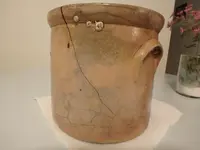Silver Tree Chaser
Bronze Member
The fields are all planted, and the woods are overgrown. The thickets, horse flies, and heat during my last cellar hole hunt made for a less than enjoyable outing even in the early morning hours. Looking for alternatives, I made a recent venture for old bottles in a shallow river. This particular area of the river flows into a salt-water cove; it can only be searched effectively during low-tide. I had searched this river several times before, recovering embossed bottles from the 1890s to 1910s, a single ginger beer bottle, a few clay pipes, marbles, and so forth. These finds were good but not great upon considering the conditions of the search – digging with a hand rake through sentiment, rock, and far more modern bottles, and of course broken glass everywhere while wearing a mask and snorkel. Heavy leather gloves, jeans, and a long-sleeve shirt for protection is a must but very comfortable in the water during the summer months. My preference were for older bottles that didn’t materialize on past visits. Last year, I passed on any search of the river all together, and kept detecting.
So my recent return to the river began as expected. I didn’t even bother to use my mask. I opened up two random holes that produced broken beer bottles, window glass, and little else. One item of apparent interest was actually a warped plastic cup for a Dunkin Donuts ice coffee.
One item of apparent interest was actually a warped plastic cup for a Dunkin Donuts ice coffee.  I soon wore a hole in my glove and figured on heading home before cutting my hand wide-open on a piece of jagged glass. I considered it far better to just cut my losses, not my hand, and just pack up, but then I saw it - a large circular rim protruding from the river bottom in 1-2 feet of water.
I soon wore a hole in my glove and figured on heading home before cutting my hand wide-open on a piece of jagged glass. I considered it far better to just cut my losses, not my hand, and just pack up, but then I saw it - a large circular rim protruding from the river bottom in 1-2 feet of water. 


“No way!” That’s what I thought. It couldn’t be the top of an old stoneware crock. It must be a broken drainage pipe. But I reached down and examined the rim of what was undoubtedly a stoneware crock. “No way that’s a whole crock!” That’s what I now thought. It must be a broken crock consisting of the rim or upper half. I dug down one side of the crock till I reached the bottom and began to work the sides, sweeping away the sand and carefully removing rock upon rock. I could see a cobalt blue flower decoration on the side of the crock through the water – this was no drainage pipe.
“No way that’s a whole crock!” That’s what I now thought. It must be a broken crock consisting of the rim or upper half. I dug down one side of the crock till I reached the bottom and began to work the sides, sweeping away the sand and carefully removing rock upon rock. I could see a cobalt blue flower decoration on the side of the crock through the water – this was no drainage pipe.  “No way – there must be a hole in it somewhere.” That’s what I thought as I slowly pulled it from the tight grip of the river bottom, but it came out whole!
“No way – there must be a hole in it somewhere.” That’s what I thought as I slowly pulled it from the tight grip of the river bottom, but it came out whole!  I pulled it out and took it home just as I found it – ¾ full with sand, rock, and broken ceramics. Here’s a photo taken when I returned home.
I pulled it out and took it home just as I found it – ¾ full with sand, rock, and broken ceramics. Here’s a photo taken when I returned home.
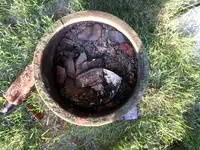
It had a crack going down the side and just about everywhere else. I stabilized the crock with water-proof Gorilla Glue to prevent any separation upon being cleaned up. So it’s damaged and not at all valuable, but it’s a complete stoneware crock from the late-1800s, which is good enough for me. I’ve wanted to find one for quite a while, but never thought it would happen so unexpectedly if at all. Before the advent of refrigeration, stoneware crocks were widely used in American kitchens to hold foodstuffs such as butter, salted meats and pickled vegetables.
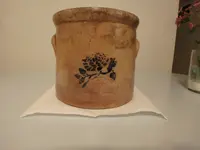
Here’s a photo of the stoneware crock after being cleaned up. I believe it’s 1 & ½ gallon in size.
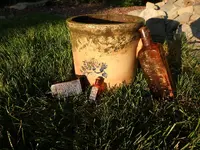
I placed the stoneware crock on the river bank and went back to my car for spare gloves. Sufficiently motivated, I donned my mask and snorkel and scored several bottles from the late 1800s to early 1900s and no cut fingers. Here a group shot of the finds.
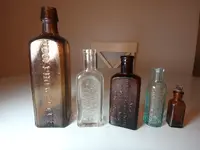
Here’s a group shot of the recovered bottles after being cleaned up.
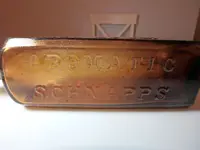

The UDOLPHO WOLFE'S Aromatic Schnapps is gin, which was sold during the second half of the 1800s. If anyone can narrow down the date, I would like to hear about it.
There are many old ads and other information that can be found for antique bottles online. This advertisement for Wolfe’s Schnapps dates from 1893.
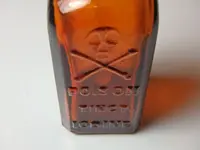
I also recovered a small poison bottle with skull & bones embossing that still had its rubber stopper with a glass applicator. I saw one of these bottles posted on TNet a short while ago. This is my first poison bottle find.
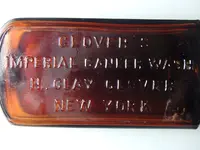
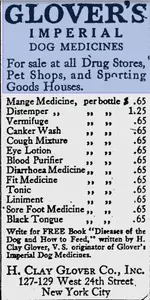
Here’s a close-up for Glover’s Imperial Canker Wash along with an old ad. It was sold from 1888 into the 20th century. It was medicine for ear cankers in dogs.
I also dug a Dr. True’s Elixir (2nd from the left in the group shot).
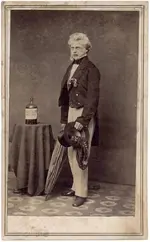
Here’s an image of Dr. True. Would you drink something sold by such a character? Despite his good name and title, Dr. True appears to have been not so true in his advertising. His elixir was sold to rid the body of pin worms, tape worms, and all sorts of pestilent creatures. His advertisements claimed that his product had relieved customers of tape worms 60, 70, even 80 feet in length – expelled alive. While other consumers of his elixir had expelled spotted lizards and “a living creature 18 inches long and two inches in circumference, a species of snake.”
Despite his good name and title, Dr. True appears to have been not so true in his advertising. His elixir was sold to rid the body of pin worms, tape worms, and all sorts of pestilent creatures. His advertisements claimed that his product had relieved customers of tape worms 60, 70, even 80 feet in length – expelled alive. While other consumers of his elixir had expelled spotted lizards and “a living creature 18 inches long and two inches in circumference, a species of snake.”
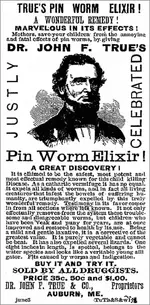
This ad from 1886 for the same elixir claims to save fortunate customers in expelling “several lizards, including one creature “18 inches in length, is spotted, belongs to the water species and looks like a veritable young alligator.”
Next time I go swimming in the mud and the muck for old bottles, perhaps I should take a few teaspoons of Dr. True’s Elixir as a precaution?
Good Hunting!
So my recent return to the river began as expected. I didn’t even bother to use my mask. I opened up two random holes that produced broken beer bottles, window glass, and little else.
 One item of apparent interest was actually a warped plastic cup for a Dunkin Donuts ice coffee.
One item of apparent interest was actually a warped plastic cup for a Dunkin Donuts ice coffee.  I soon wore a hole in my glove and figured on heading home before cutting my hand wide-open on a piece of jagged glass. I considered it far better to just cut my losses, not my hand, and just pack up, but then I saw it - a large circular rim protruding from the river bottom in 1-2 feet of water.
I soon wore a hole in my glove and figured on heading home before cutting my hand wide-open on a piece of jagged glass. I considered it far better to just cut my losses, not my hand, and just pack up, but then I saw it - a large circular rim protruding from the river bottom in 1-2 feet of water. 
“No way!” That’s what I thought. It couldn’t be the top of an old stoneware crock. It must be a broken drainage pipe. But I reached down and examined the rim of what was undoubtedly a stoneware crock.
 “No way that’s a whole crock!” That’s what I now thought. It must be a broken crock consisting of the rim or upper half. I dug down one side of the crock till I reached the bottom and began to work the sides, sweeping away the sand and carefully removing rock upon rock. I could see a cobalt blue flower decoration on the side of the crock through the water – this was no drainage pipe.
“No way that’s a whole crock!” That’s what I now thought. It must be a broken crock consisting of the rim or upper half. I dug down one side of the crock till I reached the bottom and began to work the sides, sweeping away the sand and carefully removing rock upon rock. I could see a cobalt blue flower decoration on the side of the crock through the water – this was no drainage pipe.  “No way – there must be a hole in it somewhere.” That’s what I thought as I slowly pulled it from the tight grip of the river bottom, but it came out whole!
“No way – there must be a hole in it somewhere.” That’s what I thought as I slowly pulled it from the tight grip of the river bottom, but it came out whole!  I pulled it out and took it home just as I found it – ¾ full with sand, rock, and broken ceramics. Here’s a photo taken when I returned home.
I pulled it out and took it home just as I found it – ¾ full with sand, rock, and broken ceramics. Here’s a photo taken when I returned home. 
It had a crack going down the side and just about everywhere else. I stabilized the crock with water-proof Gorilla Glue to prevent any separation upon being cleaned up. So it’s damaged and not at all valuable, but it’s a complete stoneware crock from the late-1800s, which is good enough for me. I’ve wanted to find one for quite a while, but never thought it would happen so unexpectedly if at all. Before the advent of refrigeration, stoneware crocks were widely used in American kitchens to hold foodstuffs such as butter, salted meats and pickled vegetables.

Here’s a photo of the stoneware crock after being cleaned up. I believe it’s 1 & ½ gallon in size.

I placed the stoneware crock on the river bank and went back to my car for spare gloves. Sufficiently motivated, I donned my mask and snorkel and scored several bottles from the late 1800s to early 1900s and no cut fingers. Here a group shot of the finds.

Here’s a group shot of the recovered bottles after being cleaned up.


The UDOLPHO WOLFE'S Aromatic Schnapps is gin, which was sold during the second half of the 1800s. If anyone can narrow down the date, I would like to hear about it.
There are many old ads and other information that can be found for antique bottles online. This advertisement for Wolfe’s Schnapps dates from 1893.

I also recovered a small poison bottle with skull & bones embossing that still had its rubber stopper with a glass applicator. I saw one of these bottles posted on TNet a short while ago. This is my first poison bottle find.


Here’s a close-up for Glover’s Imperial Canker Wash along with an old ad. It was sold from 1888 into the 20th century. It was medicine for ear cankers in dogs.
I also dug a Dr. True’s Elixir (2nd from the left in the group shot).

Here’s an image of Dr. True. Would you drink something sold by such a character?

This ad from 1886 for the same elixir claims to save fortunate customers in expelling “several lizards, including one creature “18 inches in length, is spotted, belongs to the water species and looks like a veritable young alligator.”
Next time I go swimming in the mud and the muck for old bottles, perhaps I should take a few teaspoons of Dr. True’s Elixir as a precaution?
Good Hunting!
Upvote
39





